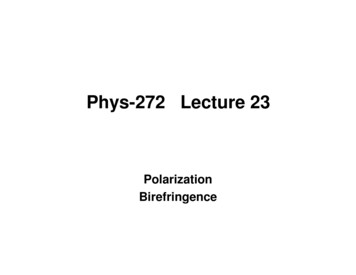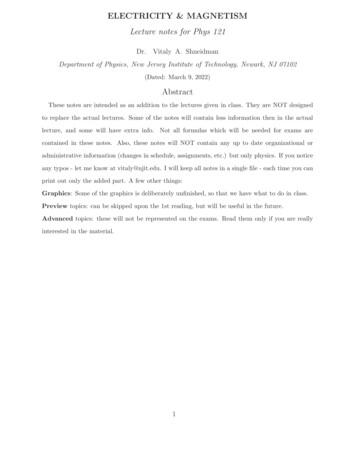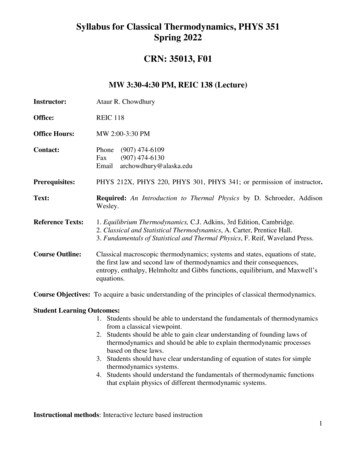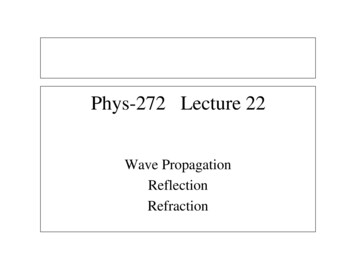
Transcription
Phys-272 Lecture 23PolarizationBirefringence
yxUP45οTAEfastwsloEsλ /4zEfRCP
PolarizationOrientation of E field matters when the EM wavetraverses matter4/20/20113
Polarization Transverse waves have a polarization– (Direction of oscillation of E field for light) Types of Polarization– Linear (Direction of E is constant)– Circular (Direction of E rotates with time)– Unpolarized (Direction of E changes randomly)yxz4/20/20114
Natural Light is Unpolarized Light from sun We can polarize light using special material Crystals, Polymers with aligned atoms 4/20/20115
Linear Polarizers Linear Polarizers absorb all electric fieldsperpendicular to their transmission axis.4/20/20116
Unpolarized Light onLinear Polarizer Most light comes from electrons accelerating in random directions and isunpolarized.Averaging over all directions, intensity of transmitted light reduces due to reductionin E4/20/2011cε0 EI 227
Linearly Polarized Light onLinear Polarizer (Law of Malus)Etranmitted Eincident cos(θ)Itransmitted IincidentTAcos2(θ)θθ is the angle betweenthe incoming light’spolarization, and thetransmission axisEabIncident Eθ4/20/2011sorbedTransmission axisETransmitted Eincidentcos(θθ)8
Law of Malus ExampleE0TA45 E1TA90 unpolarizedlightII I00TAB1I1I2 I31) Intensity of unpolarized light incident on linearpolarizer is reduced by half . I1 I0 / 22) Light transmitted through first polarizer is verticallypolarized. Angle between it and second polarizer isθ 90º . I2 I1 cos2(90º) 04/20/20119
Law of Malus ExampleE0TA45 E1TA90 unpolarizedlightI I0TAB1I1 0.5 I0I2 I1cos2(45)I32) Light transmitted through first polarizer is verticallypolarized. Angle between it and second polarizer is θ 45º.I2 I1 cos2 (45º) 0.5I1 0.25 I03) Light transmitted through second polarizer is polarized45º from vertical. Angle between it and third polarizer isθ 45º. I3 I2 cos2(45º) 0.125 I04/20/201110
Polarization by Scattering Light can also bepolarized in scatteringprocesses– Light scatters ofmolecules in air– Rotate polarizedsunglasses whilelooking at blue sky» Light gets cut off blue sky turnsbrighter and dimmeras you rotateindicatingpolarization4/20/201111
Polarization by Reflection Light can by polarized by reflectionThis is why polarizedsunglasses areeffective in reducing“glare”4/20/201112
Brewster’s angle Partial polarization onreflection Part of the light is refracted(also polarized) Depends on refractive indices– Brewster’s lawComplete polarization for Brewster's anglen2n1when reflected and refracted light pathstan θb 4/20/2011are perpendicular to one another13
So far we have considered plane waves that look like this:From now on just draw E and remember that B is still there:
Linear Polarization
The intensity of a wavedoes not depend on itspolarization:I ε 0c E 2 ε 0 c Ex2 E y2 ε 0 c Ex2 E y2 ε 0 cE02 sin 2 (kz ωt φ ) (sin 2 θ cos 2 θ )12So I 1ε 0 cE02 Just like before21
PolarizersThe molecular structure of a polarizer causes the component ofthe E field perpendicular to the Transmission Axis to be absorbed.
Polarization summaryConsider an EM plane wave.The E field is polarized in theY-direction. This is called“linearly Polarized light”.E y E 0 sin( kx ω t )Bz E0sin( kx ω t )cMost light sources are not polarizedin a particular direction. They produceunpolarized light or radiation.xpolaroid (sunglasses)Long molecules absorb Efield parallel to molecule.TA(transmission axis)
With and without a polarizing filterPolarizers at 90 and 0 degrees
Linear Polarizers/Malus’ LawTAUP(unpolarized light)I I0n̂θ TAE1θLPI1 ?LPE2I2 ? This set of two linear polarizers produces LP light. What isthe final intensity?– First LP transmits 1/2 of the unpolarized light: I1 1/2 I0– Second LP projects out the E-field component parallel to the TA:E2 E1 cosθI E2I 2 I1 cos2 θLaw of Malus
An example of Malus’ LawParallel axesPerpendicular axes
Clicker3) An EM wave is passed through a linear polarizer. Whichcomponent of the E-field is absorbed? The component of theE-field which is absorbed is .a) perpendicular to the transmission axisb) parallel to the transmission axisc) both components are absorbed
ClickerAn EM wave polarized along the yaxis, is incident on two orthogonalpolarizers.I) What percentage of the intensity gets through both polarizers?a) 50%b) 25%c) 0%Q) Is it possible to increase this percentage by inserting another polarizerbetween the original two? [not a clicker problem (yet)]
Will any light be transmitted through the crossedpolarizers ? Why or why not ?
Multi-part clicker Light of intensity I0, polarized along thex direction is incident on a set of 2linear polarizers as shown.y– Assuming θ 45 , what is I45,1Athe intensity at the exit of the 2polarizers, in terms of I0?(a)E0θTAI I0I45 ?1(b) I45 I041I 45 I 02TAx(c) I 45 01B What is the relation between I45 and I30, the final intensities in thesituation above when the angle θ 45 and 30 , respectively?(a) I 45 I30xE04530xTATAE0TAy(c) I 45 I 30(b) I 45 I30I I0yI I 0I45 ?zTAI30 ?zz
Multi-part clicker Light of intensity I0, polarized alongthe x direction is incident on a set of2 linear polarizers as shown.1A– Assuming θ 45 , what is I45,the intensity at the exit of the2 polarizers, in terms of I0?(a) I 45 1I02(b) I 45 1I04n̂ 1TAxE0θE1yn̂ 2TAI I0E2I45 ?(c) I 45 0 We proceed through each polarizer in turn.I02 The intensity after the first polarizer is: I1 I 0 cos ( 45 0 ) 2 The electric field after the first polarizer is LP at θ1 45. The intensity after the second polarizer is:I 45I1 I1 cos ( 90 45 ) 22I 45 1I04z
Multipart clicker Light of intensity I0, polarized along thexx direction is incident on a set of 2E0linear polarizers as shown.y– Assuming θ 45 , what is theI I01A relation between the I45, the intensityat the exit of the 2 polarizers, interms of I0?1(a) I 45 I 0(c) I 45 0(b) I 45 1 I 024n̂ 1TAθE1n̂ 2TAE2I45 ?1B What is the relation between I45 and I30 , the final intensities in thesituation above when the angle θ 45 and 30 , respectively?(a) I45 I30(b) I45 I30(c) I 45 I 30 In general, the first polarizer reduces the intensity by cos2θ, while thesecond polarizer reduces it by an additional factor of cos2(90 – θ). Thus, the final output intensity is given by:I30 I0 cos2 (30) cos2 (90 – 30) 0.187522222In general: Iout I0 cos (θ ) cos ( 90 θ ) I0 cos (θ ) sin (θ ) sin ( 2θ )This has a maximum when θ 45 .z
Polarization by reflectionMedium bE0E0yunpolarizednanbyθiθiθrThe reflected rays are partiallypolarized in the horizontal plane.The transmitted rays are alsopartially polarized.E0xxCan always describeE in terms ofcomponents in twoarbitrary directions.The components areequal for unpolarizedlight.
Polarization by reflectionnanbMedium bθp θpθrFrom Maxwell’s eqn. it can be shown thatBrewster’s angle is given bynbtan θ p naFor a certain angle,the Brewster angle,the reflected light iscompletely polarizedin the horizontalplane. This occurswhen the anglebetween the refl. andrefr. rays is 90o.
Light reflected on dashboard to the windshield will bepolarized in the horizontal plane. Using polaroid darkglasses with a vertical polarizationaxis will remove most of reflected light (glare).
Electric field lines from oscillating dipolefull computer simulation - a snapshot in timeNosignalNosignalThis experiment was done by Hertz with radio waves in the 19th century
Dipole radiation pattern Oscillating electric dipole generates e-m radiation that islinearly polarized in the direction of the dipole Radiation pattern is doughnut shaped & outward traveling– zero amplitude above and below dipole (sin2Θ)– maximum amplitude in-planexzy
Polarization by Scattering Suppose unpolarized light encounters an atom and scatters(energy absorbed & reradiated).– What happens to the polarization of the scattered light?– The scattered light is preferentially polarized perpendicular to theplane of the scattering.» For example, assume the incident unpolarized light is movingin the z-direction.» Scattered light observed along the x-direction (scatteringplane x-z) will be polarized along the y-direction.» Scattered light observed along the y-direction (scatteringplane y-z) will be polarized along the x-direction.yThis box contains atomsthat “scatter” the lightbeamxz
Polarization of the sky In the atmosphere light isradiated/scattered by atoms –oscillating electric dipoles.Maximum intensity Intensity lobe–Less intensityNo radiation along direction of motion!Start with sunlight with all polarizations & randomly oriented dipoles.2 cases: Dipole oscillates into the paper.Horizontal dipoles reradiateH-polarized light downward.(Do not respond to incident V-light.) –Dipole oscillates vertically.Vertical dipoles reradiate V-polarizedlight to the sides (not downward).(Do not respond to incident H-light.)
Why is the sky blue? Light from Sun scatters off of air particles–“Rayleigh scattering”– Rayleigh scattering is wavelength-dependent.– Shorter wavelengths (blue end of the visible spectrum) scatter more. This is also why sunsets are red!– At sunset, the light has to travel through more of theatmosphere.– If longer wavelengths (red and orange) scatter less – The more air sunlight travels through, the redder it willappear!– This effect is more pronounced if there are more particlesin the atmosphere (e.g., sulfur aerosols from industrialpollution).
Pixels in a LCD (Liquid Crystal Display)Apply an electric field to change the orientationof pixels and block or transmit polarized light
SunglassesApplications– The reflection off a horizontalsurface (e.g., water, the hood ofa car, etc.) is strongly polarized.Which way?– A perpendicular polarizer canpreferentially reduce this glare. Polarized sky– The same argument applies to lightscattered off the sky:Polarizing filters important in photography!
More PolarizationsrGeneral linear polarization state: E (cos θ xˆ sin θ yˆ ) E0 sin( kz ω t )if θ 45 rxˆ yˆE0 E02rxˆ yˆE What if instead we had 0E0 ?2r E0Polarized at –45 .Another way to write these:rE45 E0 xˆ sin(kz ω t ) E0 yˆ sin(kz ω t )rE 45 E0 xˆ sin(kz ω t ) E0 yˆ sin(kz ω t π )So the only difference is a phase shift of π between E0x and E0y .In general, this phase shift can take other values!
Other Polarization States? Are there polarizations other than linear?– Sure!!– The general harmonic solution for a plane wave traveling in the zdirection is:yrEE x E x 0 sin( kz ω t φ x )E y E y 0 sin( kz ω t φ y )yrEθxxφ φx φy 0LinearPolarizationE yoE xo tan θφ φx φ y CircularPolarizationE yo E xo(E0x and E0y are 90 out of phase.)π2
Clicker What is the polarization of an electromagnetic wave whose Evector is described as:E x E 0 cos( kz ω t )E y E 0 sin( kz ω t )(a) linear(b) circular(c) elliptical
Clicker What is the polarization of an electromagnetic wave whose Evector is described as:E x E 0 cos( kz ω t )E y E 0 sin( kz ω t )(a) linear(c) elliptical(b) circularNot linear because Ex and E y are out of phase.It would be “elliptical” ifyEx E y :xThe correct answer is circular (actually LCP).rE
Visualization Why do we call this circularpolarization? Basis for space vehicle antennadesigns.There is no vertical or horizontal inspace (polarization), but there isdirection of travel and helicity.Direction is well defined.Helicity – right-handed or left-handedcircular polarization. That is a welldefined polarization in space.
Example: Wave Plates Birefringent crystals with precise thicknessesEx.: Crystal which produces a phase change of π/2 “quarterwave plate” (a “full wave plate” produces a relative shift of 4 π2 2π no effect).Light polarized along the fast or slow axis merely travelsthrough at the appropriate speed polarization is unchanged.Light linearly polarized at 45 to the fast or slow axis will acquire a relativephase shift between these two components alter the state of polarization.The phase of the component along the fast axis is π/2 out of phase withthe component along the slow axis. E.g.,BeforeQWPEx E0 sin(kz ωt )Ey E0 sin(kz ωt )AfterQWPEx E0 sin(kz ωt ) πE y E0 sin(kz ωt )2Quarter Wave Plate summary: linear along fast axis linear linear at 45 to fast axis circular circular linear at 45 to fast axis
Quarter Wave Plateso Light linearly polarized at 45 incident on a quarter wave plateproduces the following wave after the quarter wave plate:Fast axis: E y E 0 cos( kz ωt )Slow axis: E x E 0 sin( kz ωt )yxUP45οRCPTARotation at t 0:Eyfastwslo EsEfλ /4xzMax vectors at t 0:QWP: fast ahead of slow by λ/4)rERCP CW
Birefringence How can we make polarizations other than linear, e.g., circular?– Birefringence!» Birefringent materials (e.g., crystals or stressed plastics) have theproperty that the speed of light is different for light polarized in the twotransverse dimensions (polarization-dependent speed), i.e., light polarized along the “fast axis” propagates at speed vfast light polarized along the “slow axis” propagates at speed vslow» Thus, if the “fast” and “slow” polarizations start out in phase, inside thebirefringent material the “fast” polarization will ‘pull ahead’:y“fast” waveϕ fast ω t fast ω dx“slow” waveϕ slow ω t slow ω dthickness, dv fastv slowϕ fast ϕ slow 11 ω d v fast v slow For a given birefringentmaterial, the relative phase isdetermined by the thicknessd, and frequency ω.
What Causes Birefringence?Birefringence can occur in any material that possesses someasymmetry in its structure, so that the material is more “springy”in one direction than another.Examples: Crystals: quartz, calciteDifferent atom spacingsin x̂ and ŷ .Long stretched molecular chains: saran wrap, cellophane tape
Birefringence in Calcite (double refraction)
Birefringence, cont.Oblong molecules: “liquid crystals” (the killer app)rEDipoles of the molecules orient along an externally appliedelectric field. Change the field change the birefringence change the polarization of transmitted light passthrough polarization analyzer to change the intensity Digital displays,LCD monitors, etc.Stress-induced birefringence:Applying a mechanical stress to amaterial will often produce anasymmetry birefringence.This is commonly used to measurestress.
Polarization by Scattering Suppose unpolarized light encounters an atom and scatters (energy absorbed & reradiated). - What happens to the polarization of the scattered light? - The scattered light is preferentially polarized perpendicular to the plane of the scattering. x y z » For example, assume the incident unpolarized light is moving in the z-direction.










